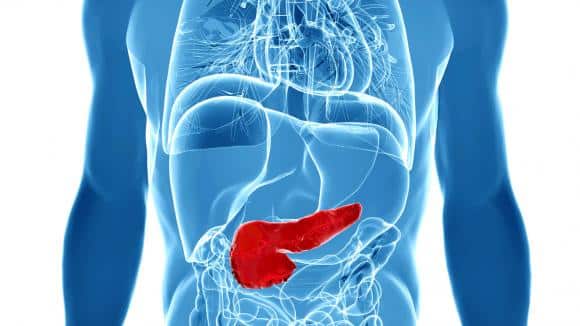What is insulin?
Insulin is a hormone produced by the pancreas to help glucose get into the body cells for energy, or to be stored for future purpose. Glucose is a form of sugar that enters the blood. Our cells need glucose for energy. However, glucose cannot directly get into the cells. After eating carbohydrate foods and your blood glucose rises, beta cells in your pancreas will be signaled to produce insulin. Insulin will then signal the body cells to absorb glucose from the bloodstream. When your body lacks insulin or is not able to respond to insulin, you may develop diabetes symptoms. Type 2 diabetic people are not able to make enough insulin or their body cannot properly respond to insulin. As a result of insulin resistance, type 2 diabetic people need extra insulin so that they can maintain a healthy blood glucose level. People with type 1 diabetes cannot produce insulin because the beta cells in the pancreas, are attacked by the immune system.
How does insulin work in the body?
Insulin works in different ways to control your blood sugar levels so that it doesn’t reach too high (a condition known as hyperglycemia) or too low (also known as hypoglycemia). When your blood sugar levels rise after taking a meal, the pancreas will release insulin into the bloodstream. Insulin will then help your cells, liver, fat and muscle absorb the glucose from the blood. This will lead to a fall in blood glucose levels. In case of extra glucose, insulin will stimulate the muscle and liver to store it in the form of glycogen. Insulin can also lower blood glucose levels by limiting the production of glucose by the liver. In case your blood glucose falls because you haven’t eaten for hours, the stored glycogen will be broken down into glucose and released into the bloodstream. This will help restore the blood glucose levels to normal. Without enough insulin in your body, your blood glucose may reach dangerous levels that could lead to serious health complications.
What does insulin do in case of an insulin resistance?
With insulin resistance, fat, muscle and liver cells cannot respond well to insulin. Therefore, glucose cannot be absorbed from the blood. This means that your body needs higher amount of insulin to help glucose get into the cells. To respond to the demand for insulin, the beta cells in the pancreas will respond by releasing more insulin. So long as there is enough insulin produced by the beta cells, the blood glucose levels will remain healthy. In case the beta cells fail to keep up with increased demand for insulin, it may lead to the risk of getting type 2 diabetes. This is because there will be excess glucose in the blood. Insulin resistance mostly affects people who do not exercise or are overweight.
Types of insulin treatment
If your body is not producing insulin or using it properly, you can take man made insulin to help you control your blood glucose levels. If you are diabetic, there are different types of man made insulin that you can use to treat diabetes. It is important to note that all types of insulin have the same effect on your body. They work by mimicking the natural increase and decrease of insulin levels in your body.
- Fast-acting insulin – this type of insulin drugs starts to work after a few minutes and peaks an hour later. The effect can last up to 5 hours. It has a clear appearance. After injecting a fast-acting insulin, you are supposed to eat immediately
- Short-acting insulin – it has a clear appearance and begins to take effect after 30 minutes. Therefore, you should inject it 30 minutes before you eat. The peak period is 2 to 4 hours and can last up to 8 hours.
- Intermediate acting insulin – this type of insulin takes effect after 2 hours and peaks after 4 to 12 hours. These effects can last up to 18 hours.
- Mixed insulin – this involves a combination of intermediate acting insulin with either fast acting insulin or short acting insulin. Therefore, you will have two types of insulin in one injection. Mixed insulin is injected before a meal so that you can have a stable amount of insulin after you eat.
- Long acting insulin – this type of insulin reaches the blood after several hours and tends to lower the blood glucose levels over a 24 hour period.
Insulin doesn’t come in tablet form because it will be digested like food when taken through the mouth. It comes in suspended or dissolved liquid. Hence it is taken with a syringe and needle or prefilled pens. Your health care provider will show you how to take insulin injections. You can also use an insulin pump to take the medication. Based on your condition such as age and how you respond to insulin, your doctor will decide which type of insulin you should use.
It is important you know the place on your body you should inject the insulin. Insulin is best absorbed when it is injected in the belly. However, you should not inject insulin near your belly button because it won’t be absorbed well. Insulin can also be injected in thighs, arms and buttocks. To avoid adverse reactions, you should not inject the same spot twice.
Insulin reactions
When you take insulin medication as advised by your doctor, it can help maintain your blood sugar levels at a healthy range. However, there are instances when your blood sugar may fall as a result of taking insulin drugs. When left untreated, low blood sugar can become serious leading to severe health complications like seizures or loss of consciousness. Insulin reactions happen as a result of taking insulin, which may lead to low blood sugar levels or hypoglycemia. If you engage in an excessive physical workout and don’t eat enough food, your blood sugar levels may drop too low. This may lead to an insulin reaction. The balance of medication and food intake does not
occur naturally. Therefore, if you take too much medication and don’t eat enough, it will lead to low blood sugar levels. To avoid the risk of insulin reaction, you need to balance the amount of insulin medication you take and the food you eat.
The following are symptoms of an insulin reaction
- Loss of consciousness
- Confusion
- Sweating
- Pale skin
- Muscle twitching
- Tiredness
- Seizures
You can prevent the effects of an insulin reaction by taking a fast acting carbohydrate. That may include simple carbohydrates like non diet coke, fruit juice or hard candy.
Doctor’s Recommendation
Disclaimer: Please note that the contents of this community article are strictly for informational purposes and should not be considered as medical advice. This article, and other community articles, are not written or reviewed for medical validity by Canadian Insulin or its staff. All views and opinions expressed by the contributing authors are not endorsed by Canadian Insulin. Always consult a medical professional for medical advice, diagnosis, and treatment.



